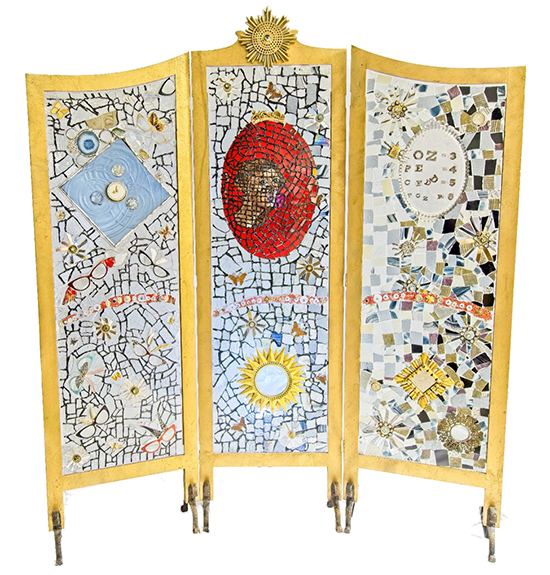Visual artist Trebs Thompson recently finished the third of a three panel, stained glass room divider, but she was working against time. About six years ago, Thompson was diagnosed with Type 2 parafoveal macular telangiectasia (MacTel), a rare, progressive disease in which blood vessels around the fovea become abnormal, and new blood vessels may form under the retina and leak. Tissue in the macula or the fovea may thin out or form a scar, causing loss of detail and central vision. Loss of central vision progresses over a period of 10 – 20 years, and Type 2 MacTel affects both eyes. To date, there are no treatments that significantly improve vision.
The three panels allow viewers to have some experience of Thompson’s visual loss journey. Pieces of mirrors are included so viewers can see themselves in the panels. The first, Losing Sight, is light with clear spaces for the lenses in the representations of thirteen pairs of glasses she had in the hope of aiding her vision. Textured glass pieces represent how she sees the world and her Amsler grid. Butterflies represent hope despite an ominous clock in the center. The second panel, Taking Flight, begins clear on the left, moving to darker, muted colors on the right. The butterflies remain but have faded. A vague cameo of a woman represents Thompson’s difficulty with facial recognition, and the clock continues its count. Finally, Going Dark, is grey with black spaces, and the butterflies have become spiders, as did the clock. But Thompson remains hopeful and determined to continue her art for as long as she can. Her next project, tentatively called The Light Inside, is a mosaic through which she wants to “make fractured light whole … to make sense of the broken pieces” of her vision.
 |
Along with loss of vision, side effects of MacTel are migraines, ocular migraines, and the pain and embarrassment of trips and falls. Despite all of that, Thompson maintains an amazingly positive attitude and incredible courage. In addition to her art, she owns and works Whimsical Farms, specializing in heirloom breed plants and animals, although she had to give up beekeeping when she could no longer distinguish the queen bee. She took judo classes until she had difficulty with her knees. She is determined to “take advantage of what’s available … tons of things!” and never give up. She will tell you, “Attitude is everything.”
You can experience Treb Thompson’s visual journey during her exhibition at the Oxford Arts Alliance, 38 S Third St, Oxford, Pennsylvania, March 4 – 25. After the exhibition, she plans to donate the panels to an eye hospital or organization for the blind and visually impaired.













